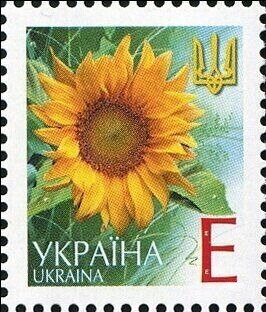Stamp: Sunflower (Ukraine 2001)
Sunflower (Ukraine 2001)
03 May (Ukraine ) within release Fifth and sixth definitive issue goes into circulation Stamp Sunflower face value Д No Face Value
Stamp is vertical format.
Best assessed against other variants by samples with the Print Order Number in the selvage. This variant, otherwise, shares multiple features with other variants. Microprint: Letter "E" twice printed on the alphabetical face value in reverse microprint. Without microprint under "E". "Е" corresponds to the surface rate of an ordinary letter up to 20 gram to the CIS- countries. Price: 0.13 $. Luminescent features: The trident, details of marigolds and grass, outline of the alphabetical face value have an intense yellow glow under UV. The legend "УКРАЇНА UKRAINA" has an intense greenish-yellow under UV. Luminescent features in this variant are 'intense' (bright). Other variants are not as bright. Print order number: 1-3284. Print order date: 03.05.2001.Also in the issue Fifth and sixth definitive issue:
- Stamp - Guelder-rose face value Ж;
- Stamp - Hollyhocks face value B;
- Stamp - Marigolds face value Д;
- Stamp - Sunflower face value Д;
- Stamp - Wheat ears face value Є;
Stamp Sunflower it reflects the thematic directions:
A flower, sometimes known as a bloom or blossom, is the reproductive structure found in plants that are floral (plants of the division Magnoliophyta, also called angiosperms). The biological function of a flower is to effect reproduction, usually by providing a mechanism for the union of sperm with eggs. Flowers may facilitate outcrossing (fusion of sperm and eggs from different individuals in a population) or allow selfing (fusion of sperm and egg from the same flower). Some flowers produce diaspores without fertilization (parthenocarpy). Flowers contain sporangia and are the site where gametophytes develop. Many flowers have evolved to be attractive to animals, so as to cause them to be vectors for the transfer of pollen. After fertilization, the ovary of the flower develops into fruit containing seeds. In addition to facilitating the reproduction of flowering plants, flowers have long been admired and used by humans to beautify their environment, and also as objects of romance, ritual, religion, medicine and as a source of food.
Flora is the plant life occurring in a particular region or time, generally the naturally occurring or indigenous—native plant life. The corresponding term for animal life is fauna. Flora, fauna and other forms of life such as fungi are collectively referred to as biota. Sometimes bacteria and fungi are also referred to as flora, as in the terms gut flora or skin flora.


